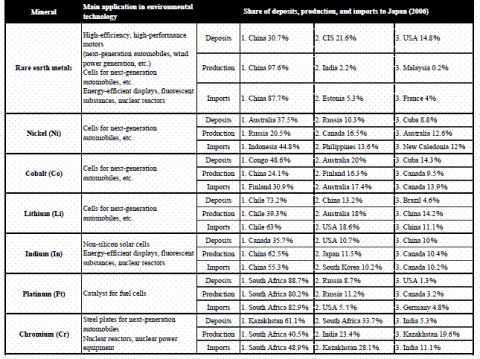- Article
- Resources & Energy
Securing Supplies of Rare Metals for Environmental Technology
July 2, 2009
Securing supplies of rare metal resources is vital if cutting-edge environmental technology is to be put to widespread use. Currently, however, Japan relies mostly on imports, meaning its supplies of these metals are vulnerable to changes in the international situation. How can Japan secure stable supplies of rare metals?
* * *
Countries around the world are forging economic policies to overcome the economic crisis, and one of the central features of these policies is that they aim to achieve economic stability by promoting environment-related industries that make use of the latest technology. With each country eager to possess the most advanced technology, international competition in this field looks set to intensify.
Any country wishing to put advanced environmental technology to practical use needs to secure rare metal resources. The Ministry of Economy, Trade, and Industry has designated 31 types of ore as rare metals, a term referring to metals that are found only in small quantities and are expensive to mine and refine. Particularly scarce are the resources collectively known as rare earth metals, a group of 17 elements with similar chemical properties that are often produced together.
Rare metals are indispensable to the production of next-generation automobiles such as hybrid and electric cars, a field in which Japan is the world leader. Cobalt and lithium are used in the manufacture of secondary cells, a core technology for these automobiles, while rare earth metals are used for high-efficiency, high-performance motors, and chromium and niobium are used to reduce body weight. In the field of solar cells, indium, gallium, and selenium are used for non-silicon thin-film electrode layers. Currently, however, Japan relies mostly on imports from overseas for its supplies of these metals, and in the case of some ores it depends overwhelmingly on specific countries. This exposes the country to the risk that changes in the international situation may disrupt its supplies of these metals ( see table ).
Table Production and Imports of Rare Metals Used in Environmental Technology

The Rise of Resource Nationalism
There has been considerable interest in recent years in Japan in recycling technology for reclaiming rare metals and other valuable metals from waste, such as used mobile phones. The potential of this technology has led some to assert that Japan is sitting on vast “urban mines” of metals. At the same time, progress is being made in developing alternative materials and technology that reduces the use of rare metals.
Nonetheless, some rare metals are very difficult to recycle or substitute because of their unique properties or uses; these are known as “critical metals.” The best example is dysprosium, one of the rare earth metals. Dysprosium is essential for improving the magnetic coercive force of the high-efficiency, high-performance motors used in next-generation automobiles, energy-saving domestic appliances, wind power generation, and other applications. It is hard to recycle or replace with an alternative material, and it is difficult to stockpile because it readily oxidizes under natural conditions. All of Japan’s dysprosium is imported from China, and measures need to be put in place to ensure a stable supply.
Demand for rare metals is increasing among countries that have set forth ambitious environmental policies. The New Energy for America program of President Barack Obama’s administration in the United States includes such specific goals as raising the amount of electricity generated from renewable energy sources to 25% by 2025 and putting 1 million US-made plug-in hybrid automobiles that can be recharged from a household electricity supply on the roads by 2015. These goals cannot be achieved without dysprosium.
At the same time, there is a growing tendency among countries that supply rare metals to limit outflows of these resources, such as by tightening restrictions on mineral development by foreign companies. China, which accounts for 90% of global production of rare earth metals, sees these materials as having national strategic importance. It is increasingly resorting to resource nationalism, adopting measures such as prohibiting mineral development by foreign companies and using export licenses to restrict exports. In December 2008 the Chinese Ministry of Land and Resources announced plans to restrict production of rare metals by 2015 and to limit the combined production of rare earth metals to 140,000 tons annually. As well as being a producer of rare metals, China is also a consumer; the restrictions are likely to be bolstered in the future to give priority to domestic demand.
Judging from current trends in rare-metal supply and demand, it is all too easy to foresee a race unfolding among countries eager to acquire rare metals. There is the worry that countries with rare metal resources will turn to “rare metal nationalism,” deliberately cutting back supplies to prioritize domestic demand and further their foreign policy. Mindful of these concerns, the United States has long had a clear strategy regarding mineral resources. Elements such as rare earth metals, platinum, indium, manganese, and niobium are deemed important from both an economic and a national security standpoint, based on which the United States has established a stockpiling system, enhanced its intelligence-gathering setup, and reinforced its supply management. The future orientation of the Obama administration’s policies for securing resources is sure to be a focus of considerable attention.
Given the present situation, if Japan is to maintain and develop its environmental technology, it must not only enhance its rare-metal recycling and substitution technologies but also establish a resource diplomacy strategy. Broadly speaking, such a strategy calls for measures in three areas of policy.
The first of these is strengthening relations with the countries that currently supply resources. Japan is particularly dependant on China for the supply of various rare-earth and other mineral resources, which means that it must strengthen its relations with China.
Japan and China have been holding conferences on rare earth metals since 1988 as a platform for exchanging views about rare-earth supply and demand, policy trends, and other issues. The first such conference in roughly three and a half years was held in April 2009, and there was particular emphasis on exchanging information relating to technology. The proceedings of past conferences show that China is interested in Japan’s outstanding rare-metal processing technology and that the country faces environmental problems, including over-mining. The Tokyo Foundation proposed in January that, as part of its resource and energy diplomacy, Japan strengthen its relations with China by conducting joint research in areas of recycling and environmental technology that can be shared, in consideration of the projects China is engaged in. Such moves must be linked to concrete policies.
The second area in which action is needed is the diversification of supply countries. As already noted, Japan is exposed to the risk of supply disruption because it relies on specific countries to supply rare metal resources ( see the propoasal ). It must boost its resources development in countries other than these in order to reduce this risk.
Toyota Tsusho Corporation announced in December 2008 that it had signed a memorandum relating to the development of rare earth mineral mines with a mining company operated by the Vietnamese government and that supplies from the venture would commence in 2011. The aim is to secure a supply of resources other than China. The public and private sectors need to work together to put in place a system for supporting overseas activities of this nature by Japanese companies. It is especially important to provide support in such areas as environmental protection measures in the region under development.
The third area of policy is opening up new frontiers. The major resource-developing corporations already have a head start on the development of many of the world’s mineral deposits, and Japan needs to open up new frontiers if it is to establish a position of strength in mineral development. One possibility in this regard is the development of ocean floor resources, for which environmental protection will be a prerequisite. Development surveys of ocean floor resources off the Japanese coast are currently underway, but Japan also needs to be proactive in carrying out surveys, including profitability studies, in other countries.
Global Warming Also Important
Rare metals are essential not just for Japan’s environmental technology but also for efforts to use technology to address global warming. The international community is currently examining sustainable energy supply and demand, and it is possible that an international framework will be put together in the near future to investigate the balance of supply and demand of rare metals necessary for sustainable energy. Japan needs to make the preparations now that will decide the diplomatic stance it can take when work begins on such a framework.
The Japanese text of this article was published in the May 26, 2009, edition of Shukan Ekonomisuto (Weekly Economist). Reprinting without the permission of Shukan Ekonomisuto is prohibited.


